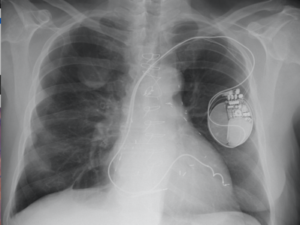Laryngitis – what’s behind it
Laryngitis – what’s behind it
Laryngitis is an inflammation of the larynx and vocal chords. This often happens in the case of a respiratory infection – such as a cold – or when the larynx becomes very irritated. The main symptom of laryngitis is hoarseness. It can last for several weeks – then it becomes chronic. Read here how to get laryngitis, how to recognize it and how to treat it.

Short overview: Laryngitis
Causes: Infection with viruses or bacteria, strained vocal cords, irritants in the air we breathe, allergies, chronic heartburn (reflux), crooked nasal septum, sinusitis,
Symptoms: Hoarseness, loss of voice, sore throat, difficulty swallowing, chesty cough, foreign body sensation in the throat, frequent clearing of throat
Therapy: Protection of the voice, avoidance of hot or spicy food, smoking, alcohol, inhalation, antibiotics only in case of bacterial infection
Diagnosis: On the basis of typical symptoms, with a laryngoscope by the ear, nose and throat doctor, laboratory determination of the pathogens.
Prognosis: Acute form usually heals quickly on its own, chronic form can recur again and again, possibly changes in the mucous membranes in the form of polyps, increase or drying up of the mucous glands.
Laryngitis: causes
A laryngitis can have different causes:
Viruses and bacteria
Mostly the reason is an infestation of the respiratory tract with viruses. Possible pathogens are for example parainfluenza and influenza viruses (influenza viruses), rhino (cold viruses) and adenoviruses. In addition, bacteria, especially streptococci, can subsequently settle on the attacked mucous membranes.
Heavily stressed vocal cords
People such as singers or teachers who put a lot of strain on their voice more often get laryngitis. The vocal apparatus is then irritated and overstrained.
Irritating breathing air
Even people who very often inhale dry air, dust, chemical fumes or irritating pollutants such as cigarette smoke quickly get laryngitis.
Allergies
Other diseases can also cause laryngitis. For example, if you have a chronically congested nose due to an allergy, you breathe almost exclusively through the mouth, which can lead to inflammation of the throat and larynx. This also applies to chronic sinusitis.
Crooked nasal septum
Also one of a bent nasal septum makes breathing more difficult. It can therefore also promote laryngitis.
Chronic heartburn (reflux disease)
In people with reflux disease, gastric juice repeatedly gets into the oesophagus – this can also cause an inflammation of the larynx.
Is laryngitis contagious?
If an infection with viruses and/or bacteria is the cause of laryngitis, it can be quite contagious. Influenza viruses spread, for example, by being expelled in the form of tiny droplets when speaking or coughing and inhaled again by other people.
However, if you get infected, you can then only get a cold or flu without it spreading to the larynx. How severe and how long a laryngitis is contagious varies depending on the pathogen.
Doctors distinguish between two forms of laryngitis, depending on the duration:
Acute laryngitis
Acute laryngitis is usually caused by an infection with viruses or bacteria. Those affected usually feel ill for a few days, have sore throats, coughs and above all are hoarse – sometimes the voice no longer works at all. Normally the acute laryngitis heals without consequences.
Chronic laryngitis
The chronic laryngitis lasts for more than three weeks. It can develop from an unhealed acute laryngitis, but also if the area of the larynx and vocal chords is permanently strained. Sometimes other diseases (such as reflux disease of the stomach) also cause chronic laryngitis.
In addition to the normal laryngitis, two other special forms are possible, which play a role especially in children:
Pseudo Krupp (Krupp syndrome)
Krupp syndrome is another name for acute stenosing laryngotracheitis. To distinguish them from the “real” croup disease, doctors often refer to them as pseudo croup. This disease occurs mainly in children between six months and three years of age.
The Krupp syndrome manifests itself mainly in a hoarse voice, a barking cough and pathological noises when inhaling (inspiratory stridor). In addition to the laryngitis, the mucous membrane in the affected children is also swollen in the area of the larynx and trachea to such an extent that the airways are constricted and the throat feels as if it is closed. Severe swelling can cause breathing difficulties for the affected child.
Epiglottitis
Another, now rare disease is the so-called epiglottitis. Mostly it affects children between the ages of two and six years. This is a special form of laryngitis, in which the epiglottis, which is located at the “entrance” to the larynx, is inflamed.
In epiglottitis, the epiglottis and larynx swell considerably. The child has high fever, severe difficulty swallowing, difficulty breathing and speaks “clotted”. Epiglottitis is an emergency that must be treated immediately by a doctor!
Laryngitis: Symptoms
The main symptom of laryngitis is hoarseness: the voice is less able to cope with stress, sounds scratchily altered (dysphonia) or fails completely, so that only a whisper is possible (aphonia). The larynx with vocal folds and vocal chords is responsible for producing sounds for speaking, singing and screaming. If it is swollen or occupied, this will be reflected in the voice.
The following symptoms are characteristic of laryngitis:
- Hoarseness
- Voice change (dysphonia)
- Sore throat
- Swallowing difficulties
- Chesty cough
- frequent clearing
- Foreign body sensation ( lump in the throat )
- possibly fever (acute laryngitis)
Laryngitis: Treatment
If the laryngitis is based on a viral infection, only the symptoms can be alleviated. Antibiotics won’t help. Only if additional bacteria are involved in laryngitis, the doctor prescribes an antibiotic that specifically combats the pathogens.
Take it easy on the neck!
In addition, only sparing the neck and letting the laryngeal mucosa swell at rest helps. The following measures can support the body:
- Try to drink as much as possible despite swallowing difficulties – especially water and not lukewarm herbal teas.
- Save your voice.
- Don’t smoke!
- Avoid dusty and dry air.
- Avoid hot and spicy food and alcohol.
Home remedy for laryngitis
Some patients use home remedies to treat laryngitis. It can be helpful, for example, to inhale hot steam and saline solutions to moisten the airways. You can also add eucalyptus oil or camomile to the water. Potato wraps and quark wraps are also classic household remedies for laryngitis.
Chronic laryngitis: Treatment often lengthy
A chronic laryngitis is often less treatable than an acute one. Then it is very important that you spare your voice and generally irritate the airways as little as possible. If you smoke, you should definitely pause it! The doctor may prescribe a cortisone preparation. It has an anti-inflammatory effect and lets the swelling subside.
Sometimes chronic laryngitis is related to a problem with voice formation. In this case it can be helpful to consult a speech therapist. If another disease is behind the laryngitis, such as chronically inflamed sinuses or reflux disease, it is important to treat it.
Laryngitis: examinations and diagnosis
Most people with an acute laryngitis consult a doctor for typical cold symptoms. He first performs a general physical examination and looks down the patient’s throat to see if the neck is reddened or the tonsils are swollen.
If laryngitis is suspected, the doctor will ask about symptoms such as sore throat, coughing and hoarseness. It is possible that he will then refer you to an ear, nose and throat (ENT) specialist.
Laryngeal examination with laryngoscope
If the patient is conspicuously hoarse or complains of pain in the larynx, the ENT physician takes a special look at the larynx for diagnosis. He uses a so-called laryngoscope for this purpose. This is a small hand-held device that is specifically designed for viewing the larynx. The doctor can examine the larynx and vocal chords via a mirror. For children or people with a strong gag reflex, the doctor uses a flexible, tube-like laryngoscope that he inserts through the nose.
Reddened, thickened, slimy
In the case of a laryngitis, the laryngoscope reveals a reddened and thickened laryngeal mucosa. Also the vocal chords are usually red and swollen. In the case of acute laryngitis, they are also often covered with viscous mucus and whitish or purulent coatings. The doctor may take a smear of the inflamed tissue to determine the exact pathogen.
Examination for cell changes
Laryngoscopy is also used to rule out other diseases, such as tuberculosis or a tumour of the larynx. This is particularly important for smokers. In cases of doubt, the doctor takes a tissue sample of the laryngeal mucosa (biopsy) to have it examined in the laboratory for cell changes.
Laryngeal inflammation: course of the disease and prognosis
Acute laryngitis is usually uncomplicated and heals within a few days without further consequences. However, anyone who does not take enough care of themselves, talks or smokes a lot during this time, risks the transition into a chronic form.
Even chronic laryngitis can regress completely if it is detected and treated in time. However, relapses occur relatively frequently. If the chronic laryngitis persists over a longer period of time, the laryngeal mucosa can change permanently.
Sometimes mucous membrane proliferations (polyps) then form. In some cases, an excessive number of mucous glands develop (laryngitis hyperplastica) or the mucous glands stop working completely (laryngitis sicca).
A pathologically altered and thickened laryngeal mucosa also increases the probability that the cells will degenerate and laryngeal cancer will develop.
About this text
This text complies with the requirements of medical literature, medical guidelines and current studies and has been reviewed by medical experts.
ICD codes are internationally valid codes for medical diagnoses. They can be found, for example, in doctor’s letters or on certificates of incapacity to work.





